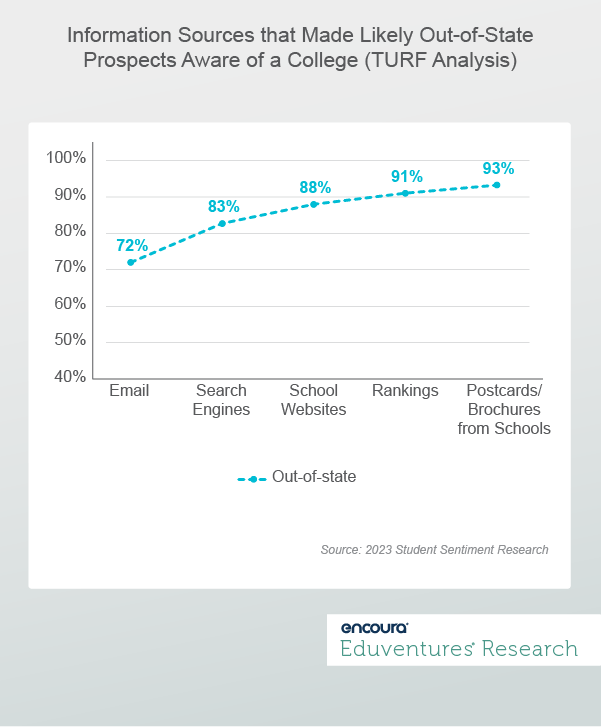Attracting out-of-state prospects is a difficult but critical endeavor, particularly in today’s world. Student demographics are expected to plummet in two years’ time and questions about the value of higher education continue to grow louder. In January, Hechinger predicted that an uptick in college closures will follow the 48 closures that occurred in 2022 and 35 closures in 2021.
More institutions have begun exploring new potential markets with favorable demographics. A recent Eduventures post addressed how to identify promising out-of-state markets, but what is the best way to reach students in these markets who may have never heard of your institution?
Raising Brand Awareness in New Markets
Few institutions are in the enviable position of being household names. Most schools must work hard to capture a prospect’s attention in their core markets, and even harder to break into new ones. A sizable portion of the recruitment budget is spent on email campaigns, print collateral, and high school visits each year. But which resources provide the best return-on-investment when it comes to raising brand awareness out-of-state?
According to findings from our Student Sentiment Research™ —Eduventures’ annual survey of high school student search preferences—just three information sources can reach almost 90% of college-bound high school students who are most likely to attend an out-of-state institution (Figure 1).

Figure 1 shows the results of a Total Unduplicated Reach and Frequency (TURF) analysis of the information sources that college-bound high school students say made them aware of specific colleges. The TURF analysis shows us which combinations of information sources (out of a broader list of 13 sources) reach the greatest share of students.
For example, the survey data suggests that institutional emails alone reach 72% of those who were unaware of the sending institution. If you combine emails and good positioning on search engines, 83% of students can be reached. A strong institutional website, in addition to emails and search engines, reaches an additional 5% of the market for a total of 88%.
After that, adding more sources shows diminishing returns, at least according to students’ self-assessments of their own search behaviors. If we take these student responses at face value, this means that the vast majority of students who would consider an out-of-state school can be made aware of your institution with just three information sources—if you get them right.
All Roads Lead to Your Website
The broad reach of email within the student consciousness is good news for recruitment marketing offices. And it makes sense that students who consider out-of-state colleges use search engines to explore the options in their top destination locations. But where do students go from there?
Typically, they will seek out your school’s website for more information. And then they return to the website throughout their searches.
Figure 2 shows the best-rated information sources according to students considering out-of-state schools at three points in time: during the initial search, when building the application list, and during the enrollment decision.

We can see that once again, students put emails at the top of their lists, closely followed by the college website. Both are particularly highly rated in the initial search stage, but unlike emails, websites drop only slightly across the other two examined stages.
Even as in-person sources like campus tours, admitted student events, and communication with admissions staff rise in prominence during the enrollment decision stage, seniors still rate the website higher than any of these. At the application and enrollment stages, it surpasses email and rises to the top of the list.
The Bottom Line
The survey data strongly indicates that students will find their way to your website—regardless of whether they first hear about your institution from an email or while conducting an online search —their interest will be sparked. Consider your website to be the central hub of your brand, a reference tool that will be revisited and reused by your key audiences.
To get your institution's brand out into new markets, however, keep investing in the channels endorsed by students themselves, like email campaigns and search engines. But don’t neglect other channels that also drive awareness with proven effectiveness, like digital advertising and a strong social media presence, that steer them to back to your website.
Successful recruitment requires an omnichannel approach. An integrated communications strategy that uses multiple recruitment channels—and the right timing—is the best way to get your institution’s name out to new markets.
Never Miss Your Wake-Up Call
Learn more about our team of expert research analysts here.
Eduventures Senior Analyst at Encoura
Contact
Use the latest data science technology from Encoura to strategically increase enrollment from secondary and tertiary markets.
Never Miss Your Wake-Up Call
Learn more about our team of expert research analysts here.

